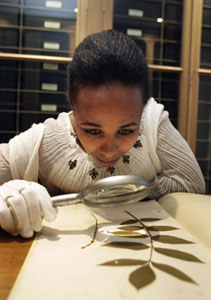
Royal Society of Chemistry -- PhD chemist, Hareg Tadesse pictured viewing a remarkable 230-year-old preserved plant produced by the Linnaean Society after discussions with the Royal Society of Chemistry, its neighbours at Burlington House in London.
Ethiopian Hareg was in London to help launch the RSC Archives for Africa initiative by which scientists in developing countries will have free access to RSC journal archives.
During PR discussions with the RSC Hareg talked about an Ethiopian plant called Brucea antdysenterica named after an 18th century British explorer, James Bruce, whose life was saved when natives in Ethiopia fed him the powdered plant in camel's milk as he lay dying of dysentery.
Bruce survived to bring the plant's seeds to London and within a few years a stem of one plant was given to the Linnaean Society where it has remained since. When the RSC sought the plant in the UK it tried a number of organisations before the Linnaean Society found the original in its records and it was painstakingly presented with cotton glove care and a constant guard while Press pictures were taken by the national Press Association.
Hareg believes that the plant may also have anti-cancer properties which she is to explore when she returns to East Africa from England where she has been studying at the University of Nottingham. Hareg explains:
"The root barks of the tree known locally ‘Yedega Abalo’ were used by people living in northern Ethiopia for many centuries for treating dysentery. The British Explorer James Bruce, who stayed in Ethiopia from 1769 to 1771, was attacked by dysentery when he was about to leave Ethiopia. When observing that he would not be able to make it to Europe travelling through the hot landmass of Sudan and Egypt, the local people informed him to take a local drug known as Yedega Abalo. The root barks of this plant were cleaned, dried in the sun, and ground into powder. Bruce was then made to take two spoonfuls of the powder with camel’s milk. After the sixth or seventh day Bruce regained his health and was able to continue his journey. On his way back, he took some of the seeds of the plant which he delivered to the botanist Daniel Solander at the British Museum, who noting that it represented a taxon planted in several British gardens. The plant was later named Brucea antidysenterica in honour of James Bruce."
Later, at the House of Commons to help launch the RSC free archives scheme she told guests:
"It is a wonderful day for African Chemistry. The visa officer in the British Embassy of Addis Ababa told me that at the moment I am the only Chemistry research student from Ethiopia in the UK.
"I am studying in Nottingham for one year as part of my Ethiopian Ph.D. And I have been asked to explain how the archives will be useful to students like me in Ethiopia.
"So I am going to tell you about the project that I did last year in Addis. I was studying the extract from a plant called with a complicated name, Brucea antidysenterica. The plant has a very special connection with the UK, particularly with Scotland.
"It was first described by the Scottish Explorer, James Bruce, who went to Ethiopia in the middle of 18th century. Just before his return to Britain, he got terrible dysentery. Happily he was cured completely by a herbal extract from this plant. He was so impressed that he took some of the seeds back home. And the plant was named in his honour, Brucea.
"And several of the compounds have shown medicinal activity and some of them are possibly anti-cancer.
"I was the first student to study the extract in Ethiopia where the plant grows. I was doing this so that Africa can benefit from the plant’s exploitation.
"But in order to do my work, I needed to know the results from previous research. And it was really hard in Addis for me to get hold of the right papers. This is where the archives are going to be so useful. Now students like me in Addis can get the RSC Archives straight away, when we need them.
"On behalf of all my fellow students in Ethiopia, I would like to congratulate the RSC on such a gesture. However the RSC is only one publisher of Chemistry Journals. And some of my key papers were not from the RSC. Therefore, I would like to call on all publishers of Chemistry Journals to follow the lead of the RSC to support young Chemists like me with their archives so that we can bring the benefits of Chemistry to our great continent."
Related Posts:
Ethiopian 'Green Chemical' Plant Could Weed Out Polluting Glue
U.S. Backing Use of DDT in Africa
No comments:
Post a Comment